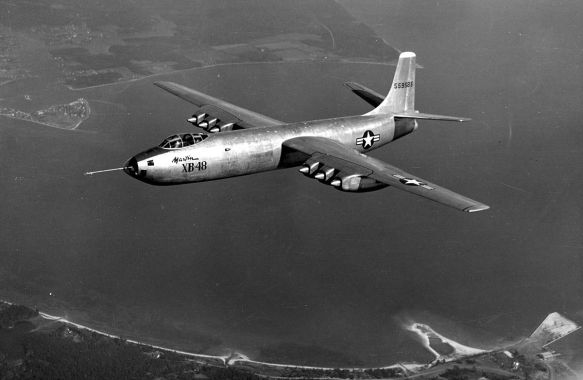
Martin XB-48 taxiing, showing, tandem main gear and nacelle outriggers
The XB-48 was Martin’s first jet bomber. Designed from Air Force specifications delineated in 1944, the XB-48 competed against North American’s XB-45, Convair’s XB-46, and Boeing’s XB-47. With the competition set, Martin proceeded with the six-engine straight-wing XB-48. Housed on each slender wing was a huge engine nacelle containing three General Electric/Allison J-35 engines.
Another new design feature of the XB-48 was its bicycle landing gear, also used by Boeing’s XB-47 entry. Bicycle landing gear, when retracted, was housed in the fuselage instead of the wing structure. Thus, wings could be designed thinner, eliminating drag penalties imposed by thicker wings. With a thinner wing, drag is reduced, and overall speed performance was increased. Martin engineers pioneered this bicycle landing gear on a heavily modified Martin B-26 that was referred to as the “Middle River Stump Jumper”. Testing proved this landing gear configuration to be so maneuverable that competitor Boeing would later select it for both the B-47, and B-52 aircraft.
Advanced technology in aerodynamics captured from the Germans at the end of World War II eluded the Martin design team. This advantage would weigh heavily in Boeing’s favor. Boeing’s XB-47 featured a swept back wing, with pylon-mounted engine nacelles versus the XB-48’s straight wing/buried wing nacelle design layout. In the end, the XB-48’s top speed of 516 mph fell far short of the XB-47’s 580 mph top speed and greater range. Martin lost that contract, and Boeing went on to produce one of the most memorable aircraft of all-time. These lessons learned from the XB-48 would greatly enhance Martin’s next jet bomber.
Specifications (XB-48)
General characteristics
Crew: three (pilot, co-pilot, and bomber-navigator)
Length: 85 ft 9 in (26.14 m)
Wingspan: 108 ft 4 in (33.02 m)
Height: 26 ft 6 in (8.08 m)
Wing area: 1,330 ft² (123.5 m²)
Empty weight: 58,500 lb (26,535 kg)
Loaded weight: 92,600 lb (42,000 kg)
Max. takeoff weight: 102,600 lb (46,540 kg)
Powerplant: 6 × General Electric J35 axial flow turbojet, 3,820 lbf (17 kN) each
Performance
Maximum speed: 454 kn (523 mph, 841 km/h) at 35,000 ft
Cruise speed: 361 kn (415 mph, 668 km/h)
Range: 1,566 nmi (1,802 mi, 2,900 km)
Combat radius: 795 mi (1,280 km)
Service ceiling: 39,400 ft (12,009 m)
Rate of climb: 4,200 ft/min (21.3 m/s)
Armament
Guns: 2 × .50 in (12.7 mm) M-2 machine guns in tail turret (proposed)
Bombs: 1 × 20,000 lb (9,980 kg) or 36 × 250 lb (113 kg)